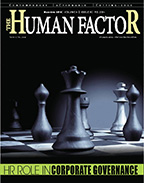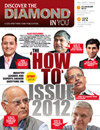Outwit, outplay, outlast ARE TEAM-BUILDING ACTIVITIES A LUXURY OR A NECESSITY FOR SENIOR EXECUTIVES? HOW CAN HR ENSURE THESE ACTIVITIES HELP LEADERS SURVIVE AND EMERGE VICTORIOUS OUT OF ANY CHALLENGE AS A TEAM? Issue Date - 01/04/2014 |
 Teamwork is a perennial buzzword in the corporate world. Regularly listed as a key requirement on job specifications, the term seems to somehow lose its importance when it comes to the executive management level of a business. In times where the economy is suffering the repercussions of a financial crisis, what happens if your company’s CEO, CFO and various heads of departments are not able to work as a team to combat challenges? Consider their backgrounds: managers have often climbed the ladder thanks to being ambitious, having a strong will, having done it ‘their way’ and who are now experts in their own right, and who may be less flexible working within the constraints of a team. While personality traits are almost impossible to change once entrenched, team-building skills can certainly be nurtured among this group. The stakes are high for upper management who face the demands of the corporate rat race. Gregory Kalabekov, director and lead facilitator of GRINESS Centre for Training and Development, says: “Wrong decisions due to miscommunication or a lack of trust could cost the company millions of dollars, and wasting valuable time trying to prevent miscommunication is counterproductive.” Adds Ebnu Etheris, founder of Teamwork Bound: “Emails and conflicting challenges between departments result in misunderstandings that may not wholly represent the individuals they are working with. “Besides enhancing interactions which can help break down the walls of pre-conceived perceptions and judgments about one another, team-building sessions designed with business goals in mind will also get senior executives on the same page.” Given that every leader is part of a larger team, should HR be organising separate team-building activities especially geared towards them? What are the best ways to engage them so they would not simply pass the activity off for ‘last-minute work commitments’ or think their time is best spent elsewhere? The team-building myth There is a huge gap between what people understand team-building to be and what it should be, according to Robert Rigg, founder of Bamboo, who believes companies in Singapore perceive team-building activities as a ‘box-ticking’ exercise and fail to understand what they truly want to achieve. In such a case, it is a safe bet to assume the activity will not deliver. Knowing the audience is as important as preparing for an annual board meeting. For example, if the event is about ‘fun’ it is vital to pick an exercise which resonates with the whole group; if it is about ‘business’, then all participants must understand the exercise they are about to undertake is part of their on-going development, and the level of engagement required from them. “Of all the events I have run that have ‘missed the mark’, the most consistent theme would be the breakdown in the communication and interpretation of the brief given to me by the client, and the brief given by the client to their senior management,” Rigg says. To get the most out of an exercise, it is critical participants be prepared for it. On the whole, he finds senior executives are generally happy being taken out of their comfort zones – but only if they are ready for what is coming. While the next step may be a challenge to achieve, it is key to maximising their experience: take them off site and ensure they are away from their BlackBerrys and email. According to Kalabekov, the definition of team-building and team-bonding has various interpretations. To some, both terms mean the same whereas others define team-building as an official company event and team-bonding as colleagues getting to know each other in an informal setting. |
 He explains team-building activities work on the principles of experiential learning, such as workshops consisting of hands-on activities, ranging from obstacle courses, to playing drums, to cooking (a recent trend). The end of such an activity is normally followed by a debrief session, where participants are challenged to think about the lessons learnt, the effect it has had on them and how it is applicable to their daily work life. Team-bonding, on the other hand, is achieved by interaction on a social level. Picture having dinner or drinks after work with your colleagues. This is suitable if there are spare funds and hardly any need for return on investment. “If companies really want to engage their senior executives, they have to create programmes tailored to the development needs of their senior executives, and not simply take a one-size-fits-all approach to the problem. What might work for junior staff is simply not going to cut it for senior management,” Rigg says. To integrate or differentiate? This is also why Etheris advises HR to consider factors such as learning objectives, organisational size and operational needs when considering whether to focus on level-by-level team-building. “Not all organisations can afford shutting the workplace down for one day and get the entire staff together for the team-building session,” he says. “Likewise, when corporate management-level discussion is the objective of the activity, gathering senior team members could be more effective than involving the entire staff.” In the latter scenario, team-building activities designed with the business’ goals in mind will get all team members on the same page. Apart from creating opportunities for all departmental heads to pull in one direction, it also breaks down silo thinking. Managers then walk away from a programme with a determined mindset to follow through on their goals, he says. Nevertheless, there are still benefits to hold mass participation activities that involve the entire staff. As organisations grow, the tendency for senior managers to not know their staff well enough becomes apparent and team-building activities will allow increased interaction between both of them. Kalabekov says in some ways, senior executives are regarded as ‘demi-gods’ in the office. Having senior management performing the same team-building activity can translate to them becoming fellow colleagues who are all working towards the same objectives. Additionally, senior management, individually or collectively, can become a role model for the rest of the company, setting the bar for teamwork. “Observing senior executives performing team-building tasks alongside other staff brings home the message that they are a team and should function as one,” he says. “Just by declaring ‘teamwork’ as the core company value it will not make staff more co-operative, rather ‘managing by example’ becomes the new core value through team-building activities.” |



